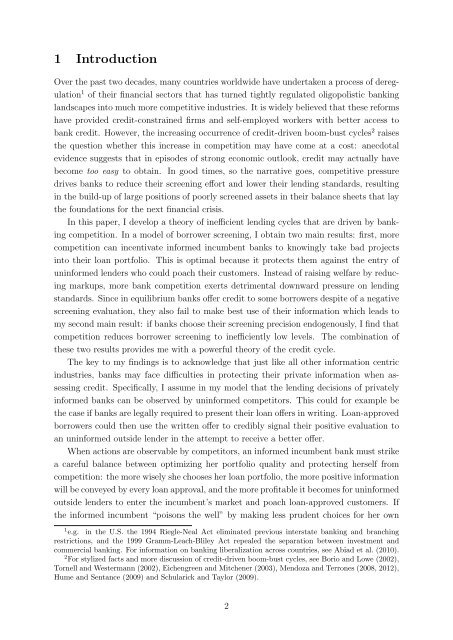Bank Competition, Information Choice and Inefficient Lending Booms
Bank Competition, Information Choice and Inefficient Lending Booms
Bank Competition, Information Choice and Inefficient Lending Booms
Create successful ePaper yourself
Turn your PDF publications into a flip-book with our unique Google optimized e-Paper software.
1 Introduction<br />
Over the past two decades, many countries worldwide have undertaken a process of deregulation<br />
1 of their financial sectors that has turned tightly regulated oligopolistic banking<br />
l<strong>and</strong>scapes into much more competitive industries. It is widely believed that these reforms<br />
have provided credit-constrained firms <strong>and</strong> self-employed workers with better access to<br />
bank credit. However, the increasing occurrence of credit-driven boom-bust cycles 2 raises<br />
the question whether this increase in competition may have come at a cost: anecdotal<br />
evidence suggests that in episodes of strong economic outlook, credit may actually have<br />
become too easy to obtain. In good times, so the narrative goes, competitive pressure<br />
drives banks to reduce their screening effort <strong>and</strong> lower their lending st<strong>and</strong>ards, resulting<br />
in the build-up of large positions of poorly screened assets in their balance sheets that lay<br />
the foundations for the next financial crisis.<br />
In this paper, I develop a theory of inefficient lending cycles that are driven by banking<br />
competition. In a model of borrower screening, I obtain two main results: first, more<br />
competition can incentivate informed incumbent banks to knowingly take bad projects<br />
into their loan portfolio. This is optimal because it protects them against the entry of<br />
uninformed lenders who could poach their customers. Instead of raising welfare by reducing<br />
markups, more bank competition exerts detrimental downward pressure on lending<br />
st<strong>and</strong>ards. Since in equilibrium banks offer credit to some borrowers despite of a negative<br />
screening evaluation, they also fail to make best use of their information which leads to<br />
my second main result: if banks choose their screening precision endogenously, I find that<br />
competition reduces borrower screening to inefficiently low levels. The combination of<br />
these two results provides me with a powerful theory of the credit cycle.<br />
The key to my findings is to acknowledge that just like all other information centric<br />
industries, banks may face difficulties in protecting their private information when assessing<br />
credit. Specifically, I assume in my model that the lending decisions of privately<br />
informed banks can be observed by uninformed competitors. This could for example be<br />
the case if banks are legally required to present their loan offers in writing. Loan-approved<br />
borrowers could then use the written offer to credibly signal their positive evaluation to<br />
an uninformed outside lender in the attempt to receive a better offer.<br />
When actions are observable by competitors, an informed incumbent bank must strike<br />
a careful balance between optimizing her portfolio quality <strong>and</strong> protecting herself from<br />
competition: the more wisely she chooses her loan portfolio, the more positive information<br />
will be conveyed by every loan approval, <strong>and</strong> the more profitable it becomes for uninformed<br />
outside lenders to enter the incumbent’s market <strong>and</strong> poach loan-approved customers. If<br />
the informed incumbent “poisons the well” by making less prudent choices for her own<br />
1 e.g. in the U.S. the 1994 Riegle-Neal Act eliminated previous interstate banking <strong>and</strong> branching<br />
restrictions, <strong>and</strong> the 1999 Gramm-Leach-Bliley Act repealed the separation between investment <strong>and</strong><br />
commercial banking. For information on banking liberalization across countries, see Abiad et al. (2010).<br />
2 For stylized facts <strong>and</strong> more discussion of credit-driven boom-bust cycles, see Borio <strong>and</strong> Lowe (2002),<br />
Tornell <strong>and</strong> Westermann (2002), Eichengreen <strong>and</strong> Mitchener (2003), Mendoza <strong>and</strong> Terrones (2008, 2012),<br />
Hume <strong>and</strong> Sentance (2009) <strong>and</strong> Schularick <strong>and</strong> Taylor (2009).<br />
2
















